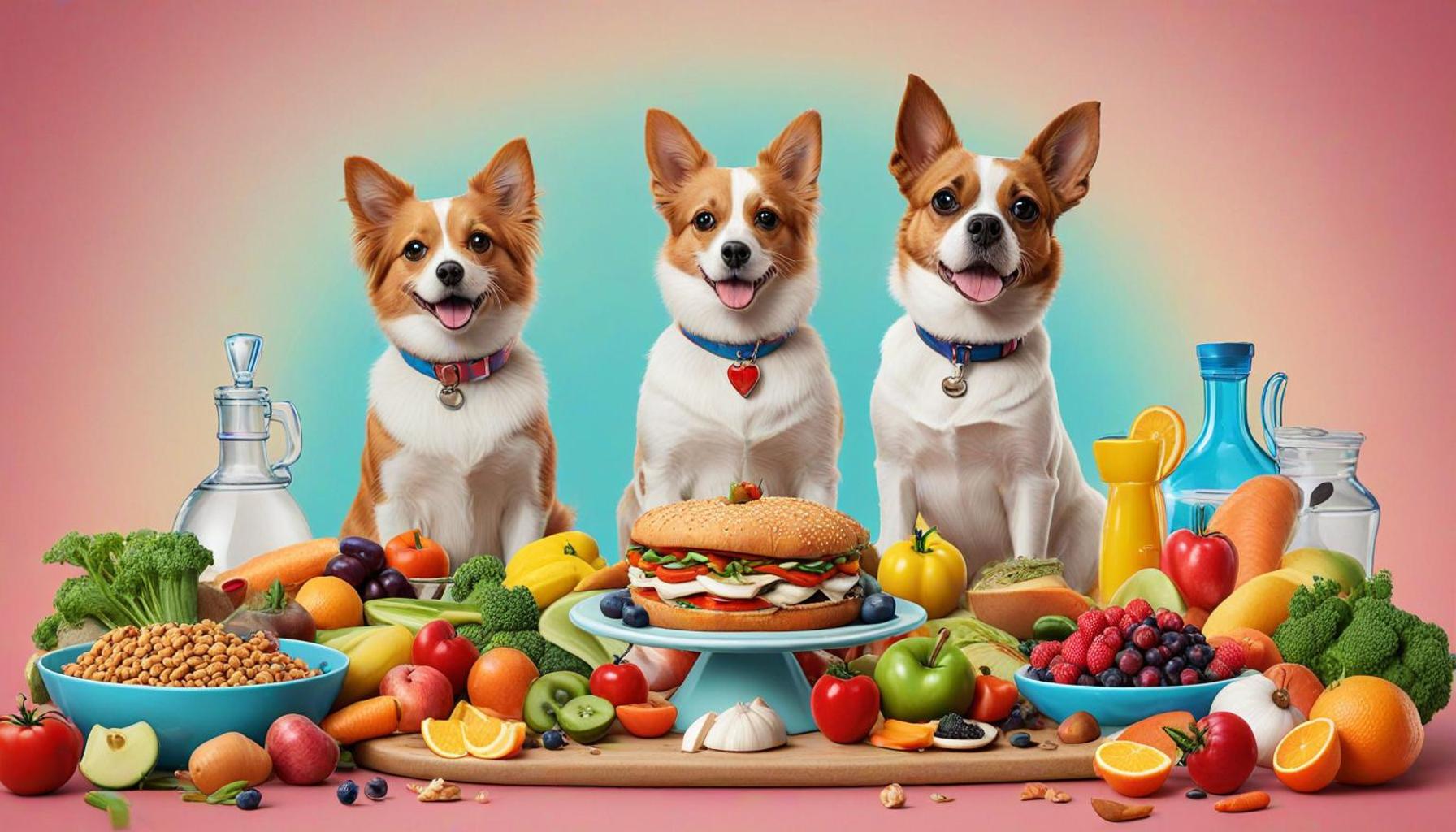How to Identify and Treat Obesity in Pets

Recognizing and Addressing the Issue
Pet obesity is an escalating dilemma that resonates with pet owners across Nigeria, where the trend of keeping dogs and cats as companions is steadily on the rise. As families increasingly welcome furry friends into their homes, it is crucial to identify the signs of excess weight and to understand its far-reaching health implications.
Research indicates that more than 30% of pets in urban centers like Lagos and Abuja are categorized as overweight or obese. This alarming trend is not merely cosmetic; it can trigger a cascade of severe health issues, including:
- Heart disease: Excess weight puts significant strain on the cardiovascular system, increasing the risk of high blood pressure and heart failure.
- Diabetes: Just like humans, pets can develop diabetes due to a lack of insulin effectiveness, exacerbated by obesity.
- Joint problems: Carrying additional weight can lead to painful conditions such as arthritis and hip dysplasia, limiting mobility and quality of life.
- Reduced lifespan: Obese pets tend to have shorter lifespans, diminishing the time owners have with their beloved companions. Research suggests that dogs and cats can live up to two years less than their lean counterparts.
Recognizing obesity in your pet involves observing specific signs that indicate health deterioration. Common indicators include:
- Difficulty in breathing: You may notice your pet wheezing or panting excessively, even during mild activity.
- Excessive weight compared to breed standards: Each breed has a standard weight range, and pets who exceed this range are more likely to be obese.
- Inability to feel their ribs easily: When a pet is at a healthy weight, you should be able to feel their ribs without exerting much pressure. If they are covered in fat, this indicates excess weight.
- Decreased activity levels: If your once-energetic pet is more lethargic and hesitant to engage in play or exercise, this could signify weight struggles.
The good news is that there are effective treatment options available. Tailoring your pet’s diet to include nutritious, lower-calorie foods while reducing portion sizes can lead to weight loss. Regular exercise is equally crucial. For instance, daily walks in a safe neighborhood or engaging in playtime with other pets can significantly enhance your pet’s physical health. Additionally, local pet care facilities or veterinarians can offer tailored exercise programs for specific breeds or age groups.
In the subsequent sections, we will delve deeper into evaluating your pet’s weight, establishing advanced and healthy feeding practices, and introducing a structured exercise regimen suitable for their size and breed. Understanding these elements is vital for fostering a long and healthy life for your furry companions.
CHECK OUT: Click here to explore more
Understanding Your Pet’s Weight
As a responsible pet owner, understanding your furry friend’s weight is crucial for their overall well-being. The journey toward a healthier pet begins with evaluating their current weight against established breed standards. Each breed comes with specific weight guidelines that allow owners to assess condition effectively. Familiarizing yourself with these standards not only helps you identify if your pet is at a healthy weight but also serves as a benchmark for future assessments.
How to Evaluate Your Pet’s Weight
To accurately evaluate whether your pet is overweight or obese, there are several methods you can employ. First, consider the Body Condition Score (BCS), a system used by veterinarians worldwide. This scoring system ranges from 1 to 9, where 1 indicates an excessively thin animal and 9 denotes an obese creature. Ideally, your pet should fall between 4 and 5 on this scale, where you can easily feel their ribs without excessive pressure, and they have a defined waist when viewed from above.
Another practical assessment is the ‘hand test’. This involves running your hands along your pet’s torso to feel any excess fat. If you cannot easily locate their ribs, this could indicate that your pet is overweight.
Recognizable Signs of Obesity
In addition to direct measurements, observe for the following visible signs that may suggest obesity in your pet:
- Abdominal sagging: A noticeable sagging belly can indicate weight gain.
- Fat rolls: Excess fat accumulation may develop as rolls, particularly around the neck and tail area.
- Unusual breathing patterns: Struggling to breathe or abnormal panting may reflect their struggle with weight.
- Reduced willingness to play: A lack of enthusiasm for playtime can indicate physical limitations due to excess weight.
It is essential to seek an expert opinion if you suspect your pet may be overweight. A visit to your veterinarian should be your next step. They can provide a proper assessment and recommend individualized weight-loss plans tailored to your pet’s needs. Often, this treatment includes dietary adjustments and increased physical activity levels.
The road to a healthier pet may seem daunting, but understanding your pet’s weight and recognizing the signs of obesity are fundamental steps that can improve their quality of life. Moreover, it allows pet owners to take proactive measures against the associated health complications of obesity, ensuring their beloved animals thrive.
In the following sections, we will explore effective feeding practices that benefit your pet’s health and innovative exercise routines designed to engage them physically and mentally, helping to combat obesity and lead them to a healthier lifestyle.
| Category | Description |
|---|---|
| Weight Management | Establishing a balanced diet tailored to your pet’s needs is crucial for effective weight management. |
| Exercise Regimen | Regular physical activity can significantly reduce obesity levels and improve overall health. |
| Veterinary Support | Consultations with a veterinarian help to assess body condition and recommend personalized treatment options. |
| Dietary Changes | Switching to specialized low-calorie diets can enhance weight loss efforts. |
| Behavior Modification | Adjusting feeding habits and managing treats can improve long-term success in obesity treatment. |
When addressing obesity in pets, it is important to identify the right strategies that work for your specific animal. These categories not only provide a structured approach to battling obesity but also offer solutions tailored to your pet’s unique needs. Understanding these elements can create a healthier lifestyle and improve life expectancy for furry friends. As you navigate through the challenges of pet health, each step you take empowers you as a responsible pet owner committed to the well-being of your companion. Exploring the key advantages of these strategies can inspire a proactive approach to maintaining your pet’s ideal weight and overall health.
SEE ALSO: Click here to read another article
Feeding Practices for Healthy Pets
One of the simplest yet most effective ways to combat obesity in pets is through proper feeding practices. Understanding what, how, and when to feed your pet can significantly impact their weight management journey. The choice of pet food plays a vital role in their overall health. Owners should look for high-quality diets that are rich in protein, low in fats, and free from excessive fillers such as corn and soy. In Nigeria, where local and imported pet food options abound, it is essential to prioritize products backed by veterinary advice.
Portion Control Matters
Maintaining appropriate portion sizes is critical in preventing overeating. Many pet owners might not realize that the recommended serving sizes on pet food bags are often just guidelines. A visit to your veterinarian can help you determine the ideal daily caloric intake based on your pet’s age, weight, and activity level. For instance, a sedentary dog might need as little as 20% fewer calories than that of an active counterpart.
Utilizing measuring cups for serving food instead of free-feeding ensures that your pet receives the right amount at each meal, reducing the chance of overeating. Additionally, consider splitting their meals into two or three servings throughout the day to maintain energy levels without overindulging.
Healthy Treat Alternatives
Treats can often contribute significant calories to your pet’s diet, making them a culprit in weight gain. Instead of high-calorie commercial treats, consider offering nutritious options available in your kitchen, such as small pieces of fruits or vegetables like carrots, green beans, or apple slices. It’s crucial to ensure that any new treats are safe for your pet, as certain foods such as grapes, onions, and avocado can be harmful.
Additionally, you can employ the training technique to incorporate exercise into the feeding process. Use their regular food as a reward during training sessions to engage their mind and body while enhancing your bond.
Innovative Exercise Routines
Beyond food, physical activity is equally essential in managing obesity. A sedentary lifestyle contributes to weight gain and numerous health issues in pets. Unfortunately, many pet owners may not realize the diverse, engaging exercises available to keep their furry friends active.
Fun Activities to Boost Physical Health
- Interactive games: Toys that encourage your pet to chase, fetch, or solve puzzles can stimulate their mind and body.
- Regular walks: Daily walks can seem mundane but can be transformed into an adventure by exploring different paths. Varying routes keeps both owner and pet engaged.
- Playdates with other pets: Socializing can also be fun! Arranging playdates with neighborhood pets can encourage exercise through natural play behaviors.
In Nigeria, pet owners have access to an increasing number of dog parks and nature trails, making it easier to incorporate these exercise habits into your routine. Be mindful of the climate as well; early mornings or late evenings are often the best times for outdoor activities to avoid the heat of the day.
Finding ways to stay active together while fostering a healthy relationship with your pet can be rewarding, enhancing their quality of life significantly. As you navigate through feeding routines and exercise, remember that gradual changes often yield the best results. Consistency is key in nurturing a healthier, happier pet.
LEARN MORE: This related article may interest you
Conclusion: Nurturing Healthier, Happier Pets
Recognizing and addressing obesity in pets is an essential responsibility that every pet owner must take seriously. The journey to a healthier pet starts with understanding how to identify the signs of obesity through regular check-ups and monitoring their body condition score. By employing effective feeding practices and maintaining a suitable exercise regime, pet owners can pave the way for significant weight management and improved quality of life for their furry companions.
It’s not just about selecting the right pet food or ensuring portion control; incorporating fun and engaging activities into your pet’s daily routine is equally critical. In Nigeria, where lifestyle dynamics differ, adapting these suggestions to fit local contexts—such as leveraging community parks or exploring diverse walking paths—can be invaluable. Moreover, utilizing healthier treat alternatives can help you keep their overall diet balanced while maintaining enthusiasm during training sessions.
As pet owners, fostering a continuous relationship through exercise and proper diet will ensure that both you and your pet remain vibrant and healthy together. Knowledge is a powerful tool that empowers you to tackle obesity head-on. By prioritizing your pet’s health, you not only enhance their well-being but also enrich your bond with them. For further guidance, be proactive in seeking advice from your veterinarian, who can offer tailored recommendations suitable for your pet’s unique needs.
In conclusion, the strides you take today can lead to a future filled with joy and vitality for your beloved companions. Let us commit to nurturing pets that thrive in health and happiness!



